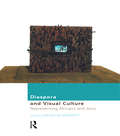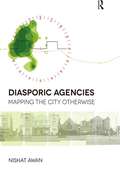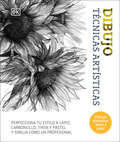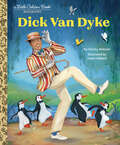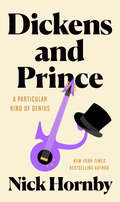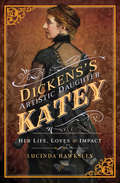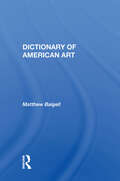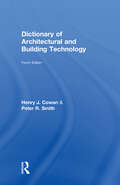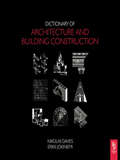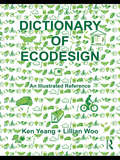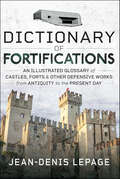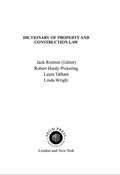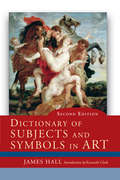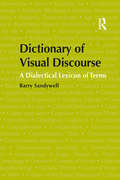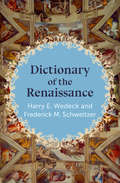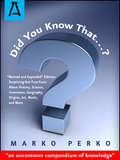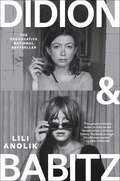- Table View
- List View
Diaspora and Visual Culture: Representing Africans and Jews
by Nicholas MirzoeffThis is the first book to examine the connections between diaspora - the movement, whether forced or voluntary, of a nation or group of people from one homeland to another - and its representations in visual culture. Two foundational articles by Stuart Hall and the painter R.B. Kitaj provide points of departure for an exploration of the meanings of diaspora for cultural identity and artistic practice. A distinguished group of contributors, who include Alan Sinfield, Irit Rogoff, and Eunice Lipton, address the rich complexity of diasporic cultures and art, but with a focus on the visual culture of the Jewish and African diasporas. Individual articles address the Jewish diaspora and visual culture from the 19th century to the present, and work by African American and Afro-Brazilian artists.
Diasporic Agencies: Mapping The City Otherwise
by Nishat AwanDiasporic Agencies addresses the neglected subject of how architecture and urban design can respond to the consequences of increasing migration. Arguing that diasporic inhabitations can only be understood as the co-production of space, subjectivity and politics, the book explores questions of difference, belonging and movement in the city. Through focusing on a series of examples, it reveals how diasporas produce new types of spaces and develop new subjectivities in the contemporary European metropolis. It explores the way in which geo-politics affects individual lives and how national and regional borders inscribe themselves onto diasporic bodies. The book claims that the multiple belongings of diasporic citizens, half-here and half-there, provoke a crisis in the standard modes of architectural representation that tend to homogenise and flatten experience. Instead Diasporic Agencies makes a case for a non-representational approach, where the displacement of the diasporic subject and their consequent reterritorialisation of space are developed as modes of thinking and doing. In parallel, mapping otherwise is proposed as a tool for spatial practitioners to work with these multi-layered spaces. The book is aimed at spatial practitioners and theorists of all sorts - architects, artists, geographers, urban designers - anyone with a general interest in mapping or those interested in working through issues related to migration and the contemporary city.
Dibujo: Técnicas artísticas (Artist's Drawing Techniques)
by DKDa rienda suelta a tu creatividad y crea una obra maestra con ejercicios paso a paso y consejos de artistas profesionales.Ya sea porque quieres probar suerte con el dibujo por primera vez o para mejorar tus habilidades artísticas, 'Pintura: técnicas artísticas' es tu libro. Aprende a trabajar con carbón, pluma y pasteles y descubre todo lo que hay que saber sobre el tono, el color, la textura, la línea y la composición con consejos detallados para artistas principiantes, intermedios y avanzados.Ejercicios paso a paso completamente ilustrados por artistas profesionales te guiarán a través de más de 80 técnicas de dibujo, que incluyen el sombreado, el puntillismo, la mezcla de colores y el 'masking'. Todas las técnicas van acompañadas de ejercicios y proyectos inspiradores para que las pruebes en casa y desarrolles tus habilidades, descubras tu propio estilo y crezcas como artista.Domina todos los aspectos del dibujo, desde seleccionar un tema hasta montar tu primera pieza, con esta guía esencial. Sea cual sea tu nivel de especialización, aprenderás a pintar con confianza y quizás crearás una obra maestra (o dos) por el camino.Kick-start your creativity and create a masterpiece with step-by-step workshops and advice from professional artists.Whether you want to try your hand at drawing for the first time or to fine-tune your artistic skills, 'Pintura: técnicas artísticas' is for you. Learn how to work with charcoal, pen, and pastels and discover everything you need to know about tone, color, texture, linework, and composition with detailed advice for beginner, intermediate, and advanced artists.Fully illustrated, step-by-step workshops from professional artists guide you through more than 80 drawing techniques, including cross-hatching, stippling, blending, and masking. All techniques are accompanied by inspiring exercises and projects to try at home to help you develop your skills, discover your own style, and grow as an artist.Master every aspect of drawing with this essential guide, from choosing a subject to mounting your first piece. Whatever your level of expertise, you can learn to draw with confidence-and maybe create a masterpiece (or two) along the way.
Diccionario de las artes (nueva edición ampliada)
by Félix de AzúaLa visión del arte de uno de los mejores escritores y más agudos pensadores de España. Diccionario de las artes es ya un clásico de la estética que ahora Félix de Azúa ha ampliado y revisado exhaustivamente para esta edición. A pesar de su título, el libro no es un diccionario al uso, sino un ensayo compuesto por diversas voces, dispuestas alfabéticamente, donde el autor medita acerca del ocaso del Arte. Para ello, regresa a los lugares del crimen, es decir, las artes y las ideas que han generado a lo largo de la historia, ese largo viaje en el que el hombre ha ido representándose y abstrayéndose a sí mismo hasta llegar a la extenuación actual. Con una estructura y un ritmo que recuerda a las variaciones musicales, Félix de Azúa, uno de los escritores más brillantes de nuestro tiempo, despliega el espectro semántico que ha generado el Arte y lo somete a una nueva formulación. La belleza, la muerte, lo sagrado o lo sublime se declinan en estas páginas a la par que se muestran los efectos, creativos o destructivos, del mercado, la publicidad y los medios de comunicación. Más que un ensayo de arte, Azúa ha concebido en esta obra imprescindible una bella y lúcida reflexión sobre la condición humana.
Dick Van Dyke: A Little Golden Book Biography (Little Golden Book Biographies)
by Christy WebsterDream big with a Little Golden Book biography about the beloved TV and movie star, Dick Van Dyke who has been entertaining audiences for more than 70 years. It's the perfect introduction to nonfiction for young readers—as well as fans of all ages!This Little Golden Book about Dick Van Dyke—the multi-talented star of movies including Mary Poppins and Chitty Chitty Bang Bang, and the classic TV comedy The Dick Van Dyke Show—is an inspiring read-aloud for young kids as well as fans of any age!Look for more Little Golden Book biographies: • Julie Andrews • Carol Burnett • Mel Brooks • Keanu Reeves • Lucille Ball
Dickens and Prince: A Particular Kind of Genius
by Nick Hornby&“An ardent fan letter from Hornby that makes you want to re-read Great Expectations while listening to Sign o&’ the Times.&” —VogueFrom the bestselling author of Just Like You, High Fidelity, and Fever Pitch, a short, warm, and entertaining book about art, creativity, and the unlikely similarities between Victorian novelist Charles Dickens and modern American rock star PrinceEvery so often, a pairing comes along that seems completely unlikely—until it&’s not. Peanut butter and jelly, Dennis Rodman and Kim Jong Un, ducks and puppies, and now: Dickens and Prince.Equipped with a fan&’s admiration and his trademark humor and wit, Nick Hornby invites us into his latest obsession: the cosmic link between two unlikely artists, geniuses in their own rights, spanning race, class, and centuries—each of whom electrified their different disciplines and whose legacy resounded far beyond their own time.When Prince&’s 1987 record Sign o&’ the Times was rereleased in 2020, the iconic album now came with dozens of songs that weren&’t on the original— Prince was endlessly prolific, recording 102 songs in 1986 alone. In awe, Hornby began to wonder, Who else ever produced this much? Who else ever worked that way? He soon found his answer in Victorian novelist and social critic Charles Dickens, who died more than a hundred years before Prince began making music.Examining the two artists&’ personal tragedies, social statuses, boundless productivity, and other parallels, both humorous and haunting, Hornby shows how these two unlikely men from different centuries &“lit up the world.&” In the process, he creates a lively, stimulating rumination on the creativity, flamboyance, discipline, and soul it takes to produce great art.
Dickens's Artistic Daughter Katey: Her Life, Loves & Impact
by Lucinda HawksleyA biography of a Victorian-era woman who grew up as the daughter of novelist Charles Dickens—and found a creative career of her own. Katey Dickens was born into a house of turbulent celebrity and grew up surrounded by fascinating, famous, and infamous people. From a very young age, she knew her vocation was to be an artist. Lucinda Hawksley charts the life of a celebrated portrait painter who redefines our preconceptions about Victorian women. Living to be almost ninety, Katey survived an unconventional marriage, love affairs, heartbreak, depression, and the challenges of being a female artist in a male-dominated era. Compelling and illuminating, this biography of Katey Dickens tells the story of a spirited woman who found fame at the center of the first celebrity phenomenon; it also uncovers the reality of what it was like to be a child of Charles and Catherine Dickens.
Dictionary Of Modern Art
by Matthew BaigellAlphabetically arranged and crossreferenced entries provide background information on major American painters, sculptors, printmakers, and photographers, plus important topics and movements central to American art from the sixteenth century to the present.
Dictionary Poetics: Toward a Radical Lexicography (Verbal Arts: Studies in Poetics)
by Craig DworkinThe new ways of writing pioneered by the literary avant-garde invite new ways of reading commensurate with their modes of composition. Dictionary Poetics examines one of those modes: book-length poems, from Louis Zukofsky to Harryette Mullen, all structured by particular editions of specific dictionaries. By reading these poems in tandem with their source texts, Dworkin puts paid to the notion that even the most abstract and fragmentary avant-garde literature is nonsensical, meaningless, or impenetrable. When read from the right perspective, passages that at first appear to be discontinuous, irrational, or hopelessly cryptic suddenly appear logically consistent, rationally structured, and thematically coherent.Following a methodology of “critical description,” Dictionary Poetics maps the material surfaces of poems, tracing the networks of signifiers that undergird the more familiar representational schemes with which conventional readings have been traditionally concerned. In the process, this book demonstrates that new ways of reading can yield significant interpretive payoffs, open otherwise unavailable critical insights into the formal and semantic structures of a composition, and transform our understanding of literary texts at their most fundamental levels.
Dictionary of Architectural and Building Technology
by Peter Smith Henry CowanA comprehensive summary of the vocabulary used across the building industry, from the preparation of an architectural brief, through creative and technical design, to construction technology and facilities management. The latest edition has several substantially revised entries as well as many new additions, including new illustrations and terms. Covering a range of disciplines across architecture and building and including both SI metric and Imperial units, this dictionary and reference work will enable students and professionals to use and understand vocabulary from other areas of expertise, and contribute to better communication.
Dictionary of Architecture and Building Construction
by Nikolas Davies Erkki JokiniemiWith more than 20,000 words and terms individually defined, the Dictionary offers huge coverage for anyone studying or working in architecture, construction or any of the built environment fields.The innovative and detailed cross-referencing system allows readers to track down elusive definitions from general subject headings. Starting from only the vaguest idea of the word required, a reader can quickly track down precisely the term they are looking for.The book is illustrated with stunning drawings that provide a visual as well as a textual definition of both key concepts and subtle differences in meaning. Davies and Jokiniemi's work sets a new standard for reference books for all those interested in the buildings that surround us.To browse the book and to see how this title is an invaluable resource for both students and professionals alike, visit www.architectsdictionary.com.
Dictionary of Ecodesign: An Illustrated Reference
by Ken Yeang Lillian WooThe first guide to the terminology of sustainable design. Written by an internationally renowned expert in the field, this illustrated dictionary provides over 1500 definitions and explanations of ecodesign terms. Providing a unique resource for the practitioner and student, this book leaves the reader free to 'dip' in and out of the book allowing for 'bite-sized' learning at their own convenience. It is an essential reference for all architects, engineers, planners and environmentalists involved in designing and planning projects and schemes in the built environment.
Dictionary of Fortifications: An Illustrated Glossary of Castles, Forts, & Other Defensive Works from Antiquity to the Present Day
by Jean-Denis LepageThis Dictionary of Fortifications is an attractive and convenient reference for anyone with an interest in castles, forts, walled cities and any other defensive architecture, including temporary structures, of any period. The heart of the book is a useful glossary of over 1,200 terms relating to fortifications through the ages. Drawn from many languages besides English, each has at least a concise definition or description, while more significant entries take the form of short articles. Many are accompanied by a clear sketch, diagram, cross-section, floor plan or map skillfully executed by the author himself. In all, there are over 400 of these black and white illustrations. Although the glossary is organized alphabetically (from Abatis to Zwischenwiderstandnet), cross references allow the reader to easily follow themes of interest through the book. Buttressing the glossary there is a section giving an overview of the historical development of fortifications from prehistory to the present day. A further chapter outlines the concomitant development of siege warfare over the same long span, detailing the evolution of siege engines and other tactics used to overcome fortifications. This is a fascinating reference for anyone with the slightest interest in military architecture.
Dictionary of Military Terms: Over 6,000 Words Clearly Defined (Dictionaries Ser.)
by Richard BowyerFirst Published in 2000. Routledge is an imprint of Taylor & Francis, an informa company.
Dictionary of Museology
by François MairesseThe internationally focused Dictionary of Museology reflects the diversity of cultural and disciplinary approaches to theory and practice in the museum field today. The museum world is changing rapidly, and the characteristics and social roles of the world’s approximately 100,000 existing museums are constantly evolving. In addition to their traditional functions of preservation, research and communication, museums are increasingly addressing issues related to social inclusion, human rights, sustainable development and finances, all of which are explored in this dictionary. Drawing on the support of an international editorial committee, including influential figures from the US, Canada, Brazil, Japan, Spain, Germany, France and the UK, this collaborative work produced by over 100 researchers from around the world provides an overview of this unique field by defining over 1,000 terms relating to museology. The Dictionary of Museology is intended for a broad spectrum of museum professionals, academics, researchers and students. The book will be especially useful to those working with international partners, since a common lexicon that conveys the complex reality of current social and cultural values is particularly vital for those working across borders.
Dictionary of Property and Construction Law
by Linda Wright J. Rostron Robert Hardy-Pickering Laura TathamThis is a new dictionary which provides a clear and concise explanation of terms used in land, property and construction law and management. The four key areas of coverage are: planning/construction law, land law, equity/trusts and finance and administration. It will be a useful reference for property and building professionals and a personal purchase for students of property and construction law on building, construction management, estate management and law courses.Jack Rostron is an experienced author and editor whose 1997 Spon title Sick Building Syndrome has been well received and widely reviewed. His co-authors contribute the necessary specialist knowledge from their respective fields of teaching and legal practice.
Dictionary of Subjects and Symbols in Art (Icon Editions Ser.)
by James HallThe understanding and enjoyment of a work of art depends as much on the story it depicts as on the artist's execution of it. But what were once biblical or classical commonplaces are not so readily recognizable today. This book relates in a succinct and readable way the themes, sacred and secular, on which the repertoire of Western art is based. Combined here in a single volume are religious, classical, and historical themes, figures of moral allegory, and characters from romantic poetry that appeared throughout paintings and sculpture in Western art before and after the Renaissance. More than just a dictionary, this text places these subjects in their narrative, historical, or mythological context and uses extensive cross-referencing to enhance and clarify the meanings of these themes for the reader. The definitive work by which others are compared, this volume has become an indispensable handbook for students and general appreciators alike. This wholly redesigned second edition includes a new insert of images chosen by the author, as well as a new preface and index to highlight the ideas, beliefs, and social and religious customs that form the background of much of this subject matter.
Dictionary of Visual Discourse: A Dialectical Lexicon of Terms
by Barry SandywellThis substantial and ambitious dictionary explores the languages and cultures of visual studies. It provides the basis for understanding the foundations and motivations of current theoretical and academic discourse, as well as the different forms of visual culture that have come to organize everyday life. The book is firmly placed in the context of the 'visual turn' in contemporary thought. It has been designed as an interdisciplinary or transdisciplinary introduction to the vocabularies and grammars of visuality that inform thinking in the arts and humanities today. It also offers insight into the philosophical frameworks which underpin the field of visual culture. A central theme that runs throughout the entries is the task of moving away from a narrow understanding of visuality inherited from traditional philosophy toward a richer cultural and multi-sensorial philosophy of concrete experience. The dictionary incorporates intertextual links that encourage readers to explore connections between major themes, theories and key figures in the field. In addition the author's introduction provides a comprehensive and critical introduction which documents the significance of the visual turn in contemporary theory and culture. It is accompanied by an extensive bibliography and further reading list. As both a substantive academic contribution to this growing field and a useful reference tool, this book offers a theoretical introduction to the many languages of visual discourse. It will be essential reading for graduate students and scholars in visual studies, the sociology of visual culture, cultural and media studies, philosophy, art history and theory, design, film and communication studies.
Dictionary of the Renaissance
by Frederick M. Schweitzer Harry E. WedeckThis A-to-Z reference offers a survey of Renaissance personalities, innovations, and other terminologies with an in-depth introduction about the period.By the fourteenth century, Italian society bore little resemblance to that of the feudal age. Merchants and financiers were establishing a new social order with greater freedom than their counterparts north of the Alps. This meant that cultural transformations would first flourish in Italy and later be carried to the rest of the continent.Dictionary of the Renaissance is a comprehensive reference guide to the period, including informative entries about major artists and other important figures, significant events and locations, and other key terms and concepts associated with the Renaissance. The introduction provides a historic overview of the cultural, political, economic, and scientific transformations that occurred in Italy between the fourteenth and seventeenth centuries.
Did You Know That…?: Surprising-But-True Facts About History, Science, Inventions, Geography, Origins, Art, Music, and More
by Marko PerkoDID YOU KNOW THAT...? : The "Revised and Expanded" Edition is an uncommon compendium of knowledge that will astound, demystify, edify, and debunk. It is a book of ambitious design that is both eminently informative and vastly entertaining. Assiduously researched, it will be the arbiter of disagreements and will stand cherished misconceptions right on their heads. It will also expose factoids, unmask present-day orthodoxy, identify misinformation, clarify the confusing, and present new information. Did You Know That...? is all you need to know...for knowledge is power!See: www.MarkoPerko.com
Didion and Babitz
by Lili AnolikNATIONAL BESTSELLER * Named a Best Book of the Year by Time, Vogue, the Washington Post, Telegraph, and more! Joan Didion is revealed at last in this outrageously provocative and profoundly moving new work "that reads like a propulsive novel" (Oprah Daily) on the mutual attractions—and mutual antagonisms—of Didion and her fellow literary titan, Eve Babitz.Could you write what you write if you weren&’t so tiny, Joan? —Eve Babitz, in a letter to Joan Didion, 1972 Joan Didion, revealed at last… Eve Babitz died on December 17, 2021. Found in the wrack, ruin, and filth of her apartment, a stack of boxes packed by her mother decades before. The boxes were pristine, the seals of duct tape unbroken. Inside, a lost world. This world turned for a certain number of years in the late sixties and early seventies, and centered on a two-story rental in a down-at-heel section of Hollywood. 7406 Franklin Avenue, a combination salon-hotbed-living end where writers and artists mixed with movie stars, rock &’n&’ rollers, and drug trash. 7406 Franklin Avenue was the making of one great American writer: Joan Didion, a mystery behind her dark glasses and cool expression; an enigma inside her storied marriage to John Gregory Dunne, their union as tortured as it was enduring. 7406 Franklin Avenue was the breaking and then the remaking—and thus the true making—of another great American writer: Eve Babitz, goddaughter of Igor Stravinsky, nude of Marcel Duchamp, consort of Jim Morrison (among many, many others), a woman who burned so hot she finally almost burned herself alive. Didion and Babitz formed a complicated alliance, a friendship that went bad, amity turning to enmity. Didion, in spite of her confessional style, is so little known or understood. She&’s remained opaque, elusive. Until now. With deftness and skill, journalist Lili Anolik uses Babitz, Babitz&’s brilliance of observation, Babitz&’s incisive intelligence, and, most of all, Babitz&’s diary-like letters—letters found in those sealed boxes, letters so intimate you don&’t read them so much as breathe them—as the key to unlocking Didion.
Die Doppelmoral des medialen ethnischen Humors: Satire, Minstrel- und Ethno-Comedy im internationalen Vergleich
by Patricia Carolina Saucedo AñezDas vorliegende Buch beschäftigt sich mit der Darstellung indigener und ethnischer Minderheiten anhand medialen ethnischen Humors und ihrer Rezeption in Lateinamerika und Europa (Argentinien, Bolivien und Deutschland). Um die Darstellungsebene zu untersuchen, wurden drei unterschiedliche Fernsehsendungen (Peter Capusotto y sus Videos – Un Programa de Rock (Argentinien), Neo tu Espacio/Los Mismos (Bolivien) und Die Bülent Ceylan Show (Deutschland) aus einem qualitativen Ansatz heraus analysiert. Die Rezeption dieser Sendungen wurde mithilfe der Durchführung von Gruppendiskussionen und Zweierinterviews mit Mitgliedern der Mehrheitsgesellschaft und der betroffenen Minderheiten (mit einem niedrigen und hohen formalen Bildungsniveau) der jeweiligen Länder erforscht. Die Ergebnisse der drei Fallstudien zeigten, dass der Einsatz medialen ethnischen Humors (Satire, Minstrel- und Ethno-Comedy) dazu beiträgt, ethnische Stereotype und volksverhetzende Aussagen zu verharmlosen und zu naturalisieren – und zwar unabhängig von den Absichten der Komiker.
Die Entgrenzung von Kindheit in der Mediengesellschaft: Kinder zwischen Talentförderung, Leistungsdruck und wirtschaftlichen Interessen
by Astrid Ebner-ZarlAstrid Ebner-Zarl unterzieht in ihrer Arbeit die These der „Entgrenzung von Kindheit“ einer eingehenden Untersuchung. Mit speziellem Fokus auf das Aufwachsen von Kindern in einer Mediengesellschaft entwickelt sie einen Beitrag zu der bislang fehlenden theoretischen Verankerung der Entgrenzungsdiagnose, und schafft dadurch ein Überblickswerk der neuen Kindheitssoziologie: Auf knapp 600 Seiten führt Astrid Ebner-Zarl die verstreuten Einzelergebnisse aus der Literatur zur Ausgestaltung von Kindheit in Geschichte und Gegenwart zusammen, verbindet sie mit theoretischen Konzepten der interdisziplinären Kindheitsforschung und vertieft sie mit einer eigenen empirischen Erhebung, der Analyse von Kindheitsbildern in den Castings Shows The Voice Kids und Kiddy Contest. Um dies zu ermöglichen, entwickelt Ebner-Zarl Auswertungstechniken für audiovisuelles Material weiter und entwirft ein auf diesen Materialtypus abgestimmtes Codiersystem. Mediatisierung, Kommerzialisierung, Sexualisierung sowie Leistungsorientierung erweisen sich theoretisch wie empirisch als prägende Elemente von Gegenwartskindheit, aber auch von Gegenwartsgesellschaft im Allgemeinen. Diese Trends sowie nicht zuletzt der soziale Konstruktionscharakter von Kindheit führen zur Erkenntnis, dass Entgrenzung von Kindheit nicht ohne die Zeitgenossenschaft von Kindern und Erwachsenen gedacht werden kann.
Die Entnazifizierung von Leni: Die unglaubliche Geschichte von Leni Riefenstahl in Nazi-Deutschland
by Lazaro DroznesNach dem Zweiten Weltkrieg versuchte das Komitee der Alliierten zur Entnazifierung, den Grad der Verantwortung eines jeden Deutschen an den Nazi-Verbrechen herauszufinden, als Teil der Demokratisierungskampagne in Nachkriegsdeutschland. Diese dramatische Fiktion bildet den Prozess von Leni Riefenstahl nach, einer sehr berühmten Filmemacherin, die verantwortlich für viele Dokumentationen war, welche das Nazi-Regime anpriesen. Einige Szenen aus ihren Dokumentationen werden als Beweisstücke gegen sie verwendet, da sie als Propaganda-Material für das Regime dienten. Leni verteidigt ihre Unabhängigkeit und Autonomie als eine Künstlerin. Im Verlauf des Prozesses werden mehrere Aspekte angesprochen, zum Beispiel die Verbindung zwischen Kunst und Politik, wie man eine Künstlerin/ein Künstler unabhängig von den politischen Kräften sein kann und die Möglichkeit, Kunst zu schaffen, und zwar nur um der Kunst willen.
Die Grüne Stadt: Stadtnatur als Ideal, Leistungsträger und Konzept für Stadtgestaltung
by Jürgen BreusteDieses Lehrbuch zur Grünen Stadt untersucht Stadtnatur als Ideal, Leistungsträger und Konzept für Stadtgestaltung. Es beantwortet wichtige aktuelle Fragen, die sich zu den ökologischen und kulturellen Grundlagen, zur Entwicklung und Struktur und zum ökologischen Leistungsvermögen von Stadtnatur weltweit stellen. Das Buch erklärt, was Stadtnatur ist, wie sie entstand und wie sie sich im Kontext zu den natürlichen und kulturellen Bedingungen ihrer Standorte entwickelte. Zudem wird beschrieben, was urbane Biodiversität ausmacht und welche Rolle differenzierte Stadtnatur im Konzept der Grünen Stadt einnimmt. Theorien der Stadtentwicklung und Ökologie werden mit praktischen Anwendungen der Stadtplanung verbunden und mit vielen Fallstudien und Beispielen veranschaulicht. Die großen Potenziale von Stadtnatur werden im Detail aufgezeigt. Um Probleme in der Stadt zu bewältigen oder zu mildern, bedarf es eines zielgerichteten, an die besonderen Bedingungen der verschiedenen Stadtnatur-Arten angepassten Stadtnatur-Managements, das Naturschutz wie Naturgestaltung gleichermaßen einschließt und dabei immer den Bezug zu den Stadtbewohnern im Auge behält.Das Lehrbuch spricht besonders Studierende und Lehrende der Fächer Stadtplanung, Ökologie, Geographie, Sozialwissenschaften sowie Praktiker der Stadtgestaltung an.
